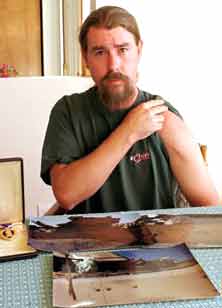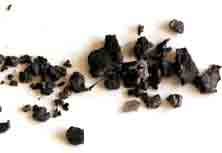| During the Persian Gulf War in 1991, the
multi-national force led by the United States
crushed the Iraqi army with overwhelming
fighting power. During this short war, the
US military lost 148 soldiers in actual combat.
Families rejoiced when their victorious husbands,
wives, sons and daughters returned home safely.
But joy quickly turned to fear when many
of those soldiers began complaining of physical
problems. Thousands died. Radiation from
DU munitions and a variety of chemical toxins
had invaded and were destroying their bodies.
(Story and photo by Akira Tashiro, senior
staff writer)
|
April 4th, 2000
| Body full of shrapnel and bone cancer Every day a fight |
Around 70 kilometers (44 miles) south of Albuquerque, the largest city in New Mexico, the home of Jerry Wheat (32) stands in a new housing development in Los Lunes.
Awakened by his wife Rebecca (30) at 10:00 on a weekend morning, Wheat descended the stairs from the second floor tying his shoulder-length blond hair behind his neck. He works for the Albuquerque Central Post Office. Having worked the night shift the previous day, he had come home earlier that morning.
"My body has been really messed up since the war. I have abdominal pains, joint pains. Right now I'm most worried about my left arm." Sitting in a chair in the dining room, he rolls up the sleeve of his T-shirt to show me a scar.
The scar is from an operation Wheat underwent in November 1998. After he complained of arm pain in September, a piece of bone was removed for a biopsy at the Veterans Hospital in Albuquerque. Two months later, he underwent an operation that replaced his bone with a metal implant.
"A tumor was growing on my bone. I'm sure it's because of the DU, but the hospital wouldn't admit that. They said, 'Well, it's not cancer, but we'll take it out anyway.'"
Wheat is positive that DU cause the cancer in his bone. On February 26, the third day of the ground war, his armored vehicle invaded southern Iraq during a fierce sandstorm and encountered the Iraqi military. During that battle, his vehicle was hit twice, both times by mistake, by shells fired from American tanks.
Wheat, the driver, was knocked unconscious by the first shell. When he came to, his clothing was on fire. He quickly removed his bulletproof vest as another fireball rose in front of him. His neck, upper back, and lower back were so hot he thought he was burning. DU shrapnel was burning his skin as it penetrated his body. Somehow, the armored vehicle was still running, and Wheat managed to drive it to a field hospital.
"Miraculously, including the five men we rescued, all nine of us in that vehicle survived." The next day, surgeons removed more than 25 pieces of shrapnel lodged up to two centimeters deep in Wheat's body. Unaware that the shells that hit his vehicle were fired by US tanks, he returned to his toxic vehicle after treatment. He continued to move with his unit until he returned to his station in Germany in early March.
It was after his discharge in March 1992 that Wheat learned that US tanks had fired the rounds that hit his vehicle. When his father, who works at Los Alamos National Laboratory, used a Geiger counter to investigate a piece of shrapnel his son had brought home, the shrapnel was clearly radioactive.
"That was a terrible shock. When I had my urine tested at the Veterans Hospital in Baltimore in 1993, DU was detected, but they said it was within normal limits."
DU particles entering the body usually lodge in the lungs and kidneys, but some eventually travel through the blood into the bones. When Wheat underwent the biopsy and operation, he asked to have the removed tissue and bone "analyzed by a private research group." His request was denied.
Wheat believes that a piece of DU shrapnel is lodged in the back of his head and another in his right arm. He lives on pain-killers.
"If it wasn't cancer they wouldn't cut out the bone, but I won't give up. I have two children to raise." As he spoke, he looked at his sons Joseph (9), and Derek (3) playing in the next room.


Jerry Wheat showing the scar on his left arm. The picture on the table shows the armored vehicle he was riding in. (Los Lunes, New Mexico)

DU shrapnel removed from Wheat's body and sleeping bag